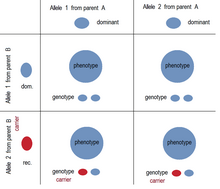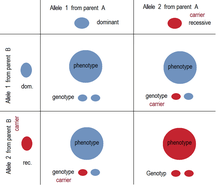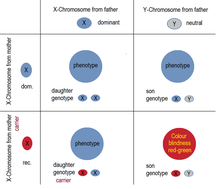A Carrier Is Someone Who

Punnett square: If the other parent does non take the recessive genetic disposition, information technology does not appear in the phenotype of the children, merely on the boilerplate 50% of them become carriers.
A hereditary carrier (genetic carrier or just carrier), is a person or other organism that has inherited a recessive allele for a genetic trait or mutation but commonly does not display that trait or show symptoms of the disease. Carriers are, notwithstanding, able to pass the allele onto their offspring, who may then express the genetic trait.
Carriers in autosomal inheritances [edit]

Punnett foursquare: If both parents are carriers, on the average 25 % of the offspring have the recessive trait in phenotype and 50 % are carriers.
Autosomal ascendant-recessive inheritance is made possible by the fact that the individuals of most species (including all higher animals and plants) have two alleles of most hereditary predispositions considering the chromosomes in the prison cell nucleus are commonly present in pairs (diploid). Carriers can be female or male as the autosomes are homologous independently from the sex activity.
In carriers the expression of a sure characteristic is recessive. The individual has both a genetic predisposition for the dominant trait and a genetic predisposition for the recessive trait, and the dominant expression prevails in the phenotype. In an individual which is heterozygous regarding a certain allele, it is not externally recognisable that it also has the recessive allele. But if the carrier has a child, the recessive trait appears in the phenotype, in example the descendant receives the recessive allele from both parents and therefore does not possess the ascendant allele that would comprehend the recessive trait. Co-ordinate to Mendelian Law of Segregation of genes an average of 25% of the offspring become homozygous and express the recessive trait. Carriers tin can either pass on normal autosomal recessive hereditary traits or an autosomal recessive hereditary disease.
Carriers in gonosomal inheritances [edit]

The female parent is a carrier of the recessive hereditary disposition for Color blindness. The Y chromosome of the father cannot oppose this. The salubrious allele on the 10 chromosome of the begetter can recoup for this in a daughter. She can encounter commonly, but she becomes a conductor. The same blueprint of inheritance applies to Haemophilia.
Gonosomal recessive genes are also passed on by carriers. The term is used in human genetics in cases of hereditary traits in which the observed trait lies on the female sex activity chromosome, the X chromosome. The carriers are always women. Men cannot be carriers because they just take ane X chromosome. The Y chromosome is non a really homologous chromosome. For this reason, the genetic brand-upwardly of the observed trait is not twofold. If a homo has a certain recessive genetic disposition on his X chromosome, this is called hemizygot and it gets phenotypically expressed. Also a recessive genetic disposition on his Y chromosome - too hemizygot - tin come up to expression, considering there is no homologous chromosome with an allele, which could overlay it. If there is no genetic information on the Y chromosome for a certain trait, the upshot of the Y is neutral and the allele on his X chromosome, which would be recessive in a heterozygous woman, can now alone come to expression.
Women have ii homologous sex activity chromosomes (20). Therefore, women can be carriers of Ten-linked genes. Examples of traits inherited via the X chromosome are color blindness and the about common hereditary form of Haemophilia. Men are affected much more often than women.[1] [2]

Inheritance by female carriers
Queen Victoria, and her daughters Princesses Alice and Beatrix, were carriers of the hemophilia cistron (an abnormal allele of a gene, necessary to produce i of the blood clotting factors). Both had children who connected to pass on the factor to succeeding generations of the imperial houses of Spain and Russia, into which they married.[3] Since males but have ane Ten chromosome, males who carried the contradistinct gene had hemophilia B. Females have two X chromosomes, so one copy of an X-linked recessive gene would cause them to be an asymptomatic carrier. These females but passed it to half of their children.[iv]
Gonosomal ascendant inheritances are likewise known. There are no carriers since owners of a ascendant hereditary disposition phenotypically express the trait in each case.
References [edit]
- ^ Neil A. Campbell, Jane B. Reece: Biologie. Spektrum-Verlag 2003, ISBN iii-8274-1352-iv, folio 308–311.
- ^ Ulrich Weber: Biologie Gesamtband Oberstufe, Cornelsen-Verlag 2001, ISBN 3-464-04279-0, page 178–182.
- ^ Potts, W.T.W. "Regal Haemophilia." Journal of Biological Didactics (Society of Biology) 30.3 (1996): 207. Academic Search Premier. sixteen Sept. 2013
- ^ Pagon, R. A.; Adam, Yard. P.; Ardinger, H. H. "Illustrated Glossary". GeneReviews. University of Washington, Seattle. Retrieved xv December 2014.
A Carrier Is Someone Who,
Source: https://en.wikipedia.org/wiki/Hereditary_carrier
Posted by: reedythrome.blogspot.com


0 Response to "A Carrier Is Someone Who"
Post a Comment